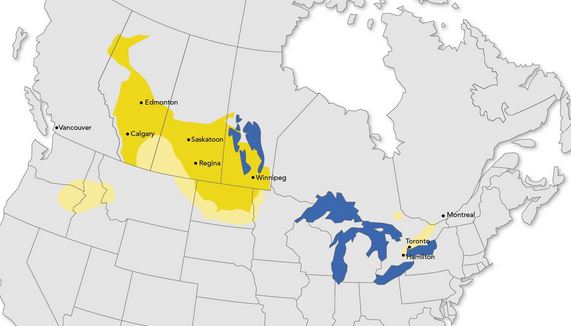
Alberta canola: about 500 acres of Canada’s 20 million (!) acres of canola.
Yesterday I wrote about honey that hurries towards granulation. Canola (the honey plant formerly known as rapeseed) is our local example of quick-setting honey. Canola honey is nice: white and mild with a slight minty flavour. I like it but I was always on guard against granulation in combs and the hardening of the workshop’s arteries of settling tanks, sumps, and pipes. They could hold solidify while filled with honey and without much warning.
Canola crystallizes quickly because of its high glucose content. Atop that, in our cool environment, combs stacked high on a hive may experience cool overnight temperatures – around 50 to 60 degrees Fahrenheit promotes granulation. The final factor is the low-water content of honey in our dry climate – the lower the moisture, the faster the granulation.
But canola is a great nectar producer. And there is a heck of a lot of it here. Western Canada has about 20 million acres of the stuff. Theoretically, that much acreage yields enough nectar for two billion pounds of honey – if there were enough bees to gather it all.
Canadian canola is found from Alberta’s north (Peace River Country, as it’s called), south into the USA, and makes an almost uninterrupted carpet of yellow all the way east to the Precambrian Shield region at the Manitoba/Ontario border. There’s even a wee bit grown north of Toronto on Ontario’s rich farmland. Here’s a map from the Canadian Canola Growers that shows canola’s extent:

Canada’s canola district.
On Canada’s western prairies, canola blooms from late June to early August. The timing depends on the local micro-climate, the arrival of spring, summer heat, and moisture in the ground. It’s almost finished here now, mostly gone to seed. So here are a few photos from the past month to show you what it looked like.

On July 11, I flew west from Calgary. Most canola is east of the city, on the prairies.
I was surprised to see this west of Calgary, near the Rocky Mountain foothills.

It’s not hard to find a canola field in July in western Canada.

Some of our bees alongside a canola field, just south of Calgary

We still call it oil seed rape in the UK. It’s very common in the countryside here too and some beekeepers have wondered how the Flow hive would cope with it.
LikeLike
Pingback: Into Big Valley | The Mountain Mystery